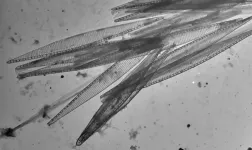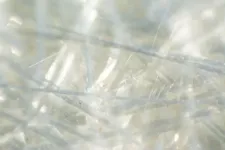(Press-News.org) NEWPORT NEWS, VA – The U.S. Department of Energy has selected Craig Ferguson to lead the Thomas Jefferson Site Office (TJSO) at the Thomas Jefferson National Accelerator Facility in Newport News, Va. As TJSO manager, Ferguson will lead in the oversight and contract management of Jefferson Lab. Additionally, Donté Davis has been confirmed as TJSO deputy manager, a role he first stepped into earlier this year.
Ferguson is familiar with Jefferson Lab and its mission, having already served in a leadership role at the lab. In 2005-2008, he was the lab’s associate director for environment, safety, health & quality.
“I am excited to return to Jefferson Lab as the DOE Site Office Manager. There are so many important and exciting things happening at this national laboratory. I see Jefferson Lab punching above its weight on so many fronts, ranging from all the terrific science to supporting a multitude of national laboratories with unique accelerator expertise. I am honored to lead and work with the Thomas Jefferson Site Office and look forward to partnering with JSA and the lab to help move the mission ahead, which is enabled by keeping our attention on good stewardship, safety, quality and solid conduct of operations.”
Ferguson’s stint at Jefferson Lab kicked off a long history of service in the national lab system. He went on to lead in several management positions at SLAC National Accelerator Laboratory, including environment, safety & health director, director of planning and assessment, and associate lab director, infrastructure and safety. Later, at the Princeton Plasma Physics Laboratory, he also served as the chief operating officer and deputy director for operations. He was also project manager and project director on various lab projects.
“Working in the national laboratory system has been so rewarding for me. Being among the brightest people on the planet to deliver and enable the various labs’ missions is a joy. I am not only talking about scientists, but everyone involved, including the people that keep our facilities clean, administrative staff, engineers and technicians. Everyone pulls the lab forward, and we are all fortunate to be a part of it.”
Most recently, Ferguson has been the senior vice president for Eastern operations for Longenecker and Associates, providing support at multiple Department of Energy and National Nuclear Security Administration facilities, Office of Science Laboratories, and Department of Energy (DOE) environmental cleanup locations.
Ferguson began his career with the United States Navy as a nuclear technician and supervisor, serving aboard the USS Theodore Roosevelt CVN-71 and the USS LY Spear AS-36.
He has an associate degree in mechanical engineering technology from Vermont Technical College, a bachelor’s degree in nuclear technology from Excelsior University, and a master’s degree in safety sciences from Indiana University of Pennsylvania. He is also a Certified Health Physicist and a certified Project Management Professional.
Davis took on the role of deputy manager earlier this year to aid the office’s transition to new leadership as a new manager was sought. He comes to the TJSO with 18 years of experience within the DOE. As deputy manager, Davis will support the office’s wide range of oversight programs.
“I am stoked, yet humbled by the opportunity to be a part of Jefferson Laboratory and the incredible professionals that are devoted to world class science. I’m grateful for the many leaders and mentors that invested in me positioning me to serve the TJSO staff and to efficiently and effectively steward the mission of the laboratory,” he said.
Before coming to Jefferson Lab, Davis most recently led the Mission Integration and Projects Division as its director in the Oak Ridge National Laboratory Site Office (OSO) in Oak Ridge, Tennessee. He also served in the Office of Science Integrated Support Center (now known as the Consolidated Service Center) as the assistant manager for Safeguards, Security and Emergency Management.
Davis has a bachelor’s degree in electrical engineering from South Carolina State University and a master’s degree in information technology management from Webster University.
Ferguson and Davis both recently took on their new roles in late May.
Further Reading
Previous Leadership: Craig Ferguson
-end-
Jefferson Science Associates, LLC, manages and operates the Thomas Jefferson National Accelerator Facility, or Jefferson Lab, for the U.S. Department of Energy's Office of Science. JSA is a wholly owned subsidiary of the Southeastern Universities Research Association, Inc. (SURA).
DOE’s Office of Science is the single largest supporter of basic research in the physical sciences in the United States and is working to address some of the most pressing challenges of our time. For more information, visit https://energy.gov/science.
END
Children who receive high-quality child care as babies, toddlers and preschoolers do better in science, technology, engineering and math through high school, and that link is stronger among children from low-income backgrounds, according to research published by the American Psychological Association.
“Our results suggest that caregiving quality in early childhood can build a strong foundation for a trajectory of STEM success,” said study author Andres S. Bustamante, PhD, of the University of California Irvine. “Investing in quality child care and early childhood education could help ...
Washington, June 15, 2023—The top 5 percent of teachers most likely to refer students to the principal’s office for disciplinary action do so at such an outsized rate that they effectively double the racial gaps in such referrals, according to new research released today. These gaps are mainly driven by higher numbers of office discipline referrals (ODRs) issued for Black and Hispanic students, compared to White students. The study, published in Educational Researcher, a peer-reviewed journal of the American Educational Research ...
Spanning about one-third of Florida’s East coast, the Indian River Lagoon has faced frequent harmful algal blooms in recent years. Among them, Pseudo-nitzschia spp., algae that produces the neurotoxin domoic acid.
Domoic acid can bioaccumulate within food webs, causing sickness and death in higher trophic level organisms such as marine mammals and birds, and have been documented in sea turtles in Florida coastal waters and in bull sharks within the Indian River Lagoon system. In humans, consumption of shellfish contaminated with domoic acid can cause harmful symptoms.
Unlike other harmful algal blooms, Pseudo-nitzschia are not bioluminescent and do not cause water discoloration ...
Chronic diseases (NCDs) are a global health epidemic and almost 80% of them occur in low- and middle-income countries. While the WHO have developed policies to combat chronic diseases, research shows that, in certain regions, they are not having the desired effect, leaving fragile health systems increasingly overwhelmed. In order to combat this, thanks to a Horizon Europe grant, Amsterdam UMC is set to lead a global consortium with the aim of developing interventions that work in practice.
Consortium leader and Professor of Global Migration, Ethnicity and Health at Amsterdam UMC, Charles Agyemang notes that, ...
Perfect noncaloric replacements for sugar and high fructose corn syrup just don’t exist yet. For example, some alternatives have a lingering sweet aftertaste and lack a sugar-like mouthfeel, leaving consumers unsatisfied. Now, researchers in ACS’ Journal of Agricultural and Food Chemistry propose adding blends of nutritionally important mineral salts to make noncaloric sweeteners seem more like the real thing. Taste-testers indicated that these blends gave zero- and low-calorie drinks a better ...
Keeping up with the journeys of wolves and welfare of wild horses has never been easier. With a GPS wildlife tracker powered by an animal's own movements, University of Copenhagen researchers have solved a problem faced by biologists and wildlife managers seeking to track wild animals year after year: dead batteries.
The wolf’s comeback in Europe has preoccupied people all across the continent over the last years. Where is it? What is its range? What does it live on? The only way to get solid answers to these questions is through GPS tracking. In ...
Statement Highlights:
Nearly 1 in 3 Black adults may develop peripheral artery disease (PAD), compared to about 1 in 5 Hispanic or white adults. If amputation is necessary for treatment, Black, Hispanic and American Indian adults experience lower survival rates and worse quality of life after amputation compared to white adults.
Multiple social, economic and health variables contribute to disparities by sex, race and ethnicity in the development, diagnosis and treatment of PAD.
Opportunities to address disparities include greater focus on prevention in health care systems, ...
This new work focused on a particular subset of E. coli with a specific capsule - the extracellular barrier that surrounds a bacterium - which scientists have called K1. E. coli with this type of capsule are known to cause invasive diseases such as bloodstream or kidney infections, and meningitis in newborns. This is because this particular cover allows them to mimic molecules already present in human tissues and enter the body unnoticed.
The researchers present evidence that targeting the capsule can be used ...
New research published in the CABI journal Human-Animal Interactions has revealed that only 30% of show horse owners surveyed in Australia agreed with a ban on the trimming of facial hair prior to its implementation in July 2022.
The research found that when asked if facial hair trimming should be banned in all equine competitions, most disciplines broadly agreed (60.5% to 84.6%) apart from showing with only 22.9% of respondents agreeing with a ban.
Indeed, some who took part in the research also believed that horses did ...
Researchers at the University of Birmingham have demonstrated that silver retains antimicrobial activity for longer when it is impregnated into ‘bioactive glass’, and shown for the first time how this promising combination delivers more long-lasting antimicrobial wound protection than conventional alternatives.
Bioactive glasses are a unique class of synthetic biomaterials made from silicone and have been used for some years in bone grafting.
Silver has long been known to prevent or reduce the growth ...


